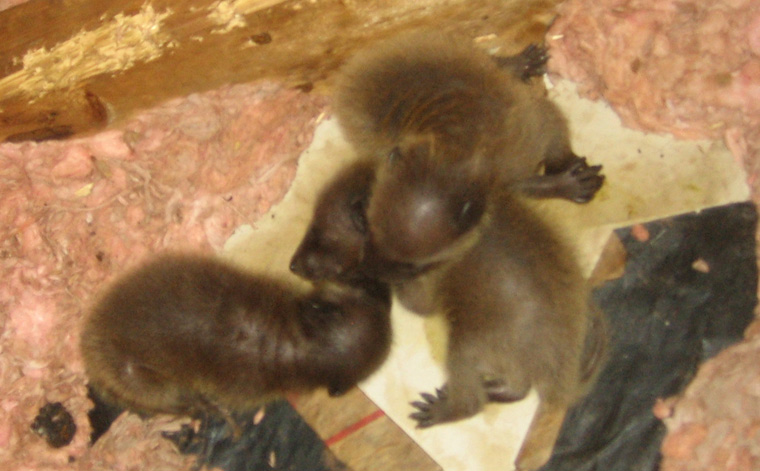-
info@aaanimalcontrol.com
Call us for help in your town
Humane Wildlife Education
How do I know if there are baby wild animals in the attic?
Need wildlife removal in your hometown? We service over 500 USA locations! Click here to hire us in your town and check prices - updated for year 2020.
It won't be long before you find out about a nest of baby animals in the attic. Although these critters have become quite good at living quietly alongside humans, and sometimes even in the same buildings, they haven't quite worked out how to be silent as they go about their business yet. There’s a very high chance that you will hear these animals, no matter how big or small they are, before you see them.

The first clue that you have baby wild animals in the attic will often the noise that they make.
You will hear all sorts of noise coming from the attic if there are critters living up there, and the more noise they make, the heavier the animal is likely to be. Larger thumbs, drags, and scuffle noises are generally going to be coming from larger scavengers, such as raccoons and opossums. Fluttering noises could be things such as birds, bats, and maybe even flying squirrels. You've got chewing noises too, and this will usually be coming from a rat, a mouse, or a squirrel.
Most of these creatures are nocturnal, although it is not unusual to hear them during the day, or even see them during the day in some cases. If you can hear thumping or thudding, scuffling or rustling noises coming from your attic during the night, there is a very high chance you have a small family of wild critters up there. There is very rarely just the one animal on its own. Animals that invade your attic do so to get away from predators, and that's normally because they have youngsters in tow. This is even more so the case when it is spring or summer, when most mother wild animals will give birth.
The second clue that you have baby wild animals such as baby squirrels in the attic will be the ‘signs and symptoms’ of an animal invasion.
Alongside hearing these wild animals, you’ll probably find 'signs and symptoms’ of invasions, and this will include droppings and urine scattered all around the place, cereal boxes being nibbled at by tiny teeth of rats and mice, and maybe even holes in the lawn from where creatures such as opossums and skunks have gone digging for grubs and worms. Even if you were to have baby animals in the attic — animals that were too small to leave the nests themselves — the mothers would still need to go out and find food, to feed both herself and her youngsters.
One of the biggest signs that an animal has invaded your home, is a hole. This could be very small, in the cases of rodents such as rats and mice, but it could be very large too. Raccoons, for example, can pull tiles away from roofs, and can even pull screens away from windows, un-latch windows and doors, tear away siding, and more. A chewing action is probably going to be have been caused by something like a squirrel, a rat or a mouse, but you will spot feces, and maybe even staining left behind by the grease on their fur or urine too.
The feces will often give you a great idea of what kind of animal invasion you have on your hands. The bigger the poop, the larger the animal. Also, even though mouse and rat poop look very similar, there are very clear differences between the two that will enable you to work out which one it is.
For more information, you may want to click on one of these guides that I wrote:
How To Guide: Who should I hire? - What questions to ask, to look for, who NOT to hire.
How To Guide: do it yourself! - Advice on saving money by doing wildlife removal yourself.
Guide: How much does wildlife removal cost? - Analysis of wildlife control prices.
animals in the attic
noises in the attic


















